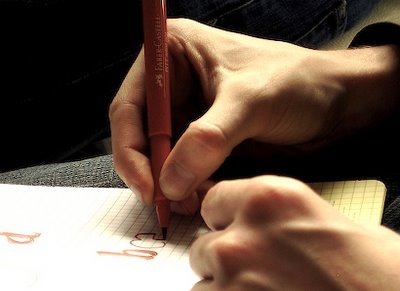The end of David Carson?
I just spent some days in Berlin and I'm trying to put the (much too) premature summery feeling of the place behind me. I've got work to do.
Setting up this blog right now isn't exactly what I call responsible behaviour either. Certainly considering the workload of the animation project I'm working on. But heck, if I'm going to attempt to organize myself, I might aswell do it when things are already interesting.

I sat out the three-day design conference TypoBerlin at the KulturHaus. Exhausting as it may have been, it was certainly fascinating.
I was impressed by Kalle Lasn from Adbusters, who held the opening speech. If you haven't heard about Adbusters, you should. — Witnessing a passionate anti-consumerist speech to a room full of institutionalized art directors is very inspirational. It certainly brought ideas to my mind. But more on those later.
I'm not going to go into the entire conference. It had some spectacular highlights (with people like Chip Kidd, Underware or Simon Waterfall at Poke).
I was surprisingly disappointed by world renowned David Carson. — I'd always enjoyed his freshness towards visual culture. In his presentation at TypoBerlin he seemed to have become a dull repeat of himself. I'm not quite sure why. I suspect being called the enfant terrible of a tiny subculture for too long works counterproductive.
The work, although it was sometimes visually impressive, was really a never-ending reflection of Carson's personality — rather than that of an interaction between Carson and the content he was supposed to deal with. His subjectivity had become a style, rather than a language.
I am nevertheless still tempted to agree with David Carson on the role of the designer. That of the subjective interpretor. — In Hillman Curtis' AIGA Carson short documentary, we get a very interesting viewpoint on this. — Carson tells us he wants his revolution to go on. The man rarely sounds like he takes design seriously. I think, in fact, he does very much so.
I think that revolution is one towards design as a more autonomous discipline. Certainly, in an age where newspaper design is being taken over by artifical intelligence, graphic design needs to emphasize its humanity rather than its technological resourcefulness.
Carson —not unlike print— has not really come to an end, it's just that he (or it) could really use a new beginning.
Setting up this blog right now isn't exactly what I call responsible behaviour either. Certainly considering the workload of the animation project I'm working on. But heck, if I'm going to attempt to organize myself, I might aswell do it when things are already interesting.

I sat out the three-day design conference TypoBerlin at the KulturHaus. Exhausting as it may have been, it was certainly fascinating.
I was impressed by Kalle Lasn from Adbusters, who held the opening speech. If you haven't heard about Adbusters, you should. — Witnessing a passionate anti-consumerist speech to a room full of institutionalized art directors is very inspirational. It certainly brought ideas to my mind. But more on those later.
I'm not going to go into the entire conference. It had some spectacular highlights (with people like Chip Kidd, Underware or Simon Waterfall at Poke).
I was surprisingly disappointed by world renowned David Carson. — I'd always enjoyed his freshness towards visual culture. In his presentation at TypoBerlin he seemed to have become a dull repeat of himself. I'm not quite sure why. I suspect being called the enfant terrible of a tiny subculture for too long works counterproductive.
The work, although it was sometimes visually impressive, was really a never-ending reflection of Carson's personality — rather than that of an interaction between Carson and the content he was supposed to deal with. His subjectivity had become a style, rather than a language.
I am nevertheless still tempted to agree with David Carson on the role of the designer. That of the subjective interpretor. — In Hillman Curtis' AIGA Carson short documentary, we get a very interesting viewpoint on this. — Carson tells us he wants his revolution to go on. The man rarely sounds like he takes design seriously. I think, in fact, he does very much so.
I think that revolution is one towards design as a more autonomous discipline. Certainly, in an age where newspaper design is being taken over by artifical intelligence, graphic design needs to emphasize its humanity rather than its technological resourcefulness.
Carson —not unlike print— has not really come to an end, it's just that he (or it) could really use a new beginning.


0 Comments:
Post a Comment
<< Home